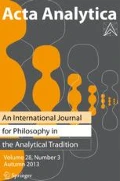Abstract
Despite its admirable bottom-up methodology, Roy Sorensen's Seeing Dark Things (OUP, 2008) raises difficult theoretical questions concerning the metaphysics and perception of absences. Metaphysical difficulties include how to individuate, count, locate, and classify absences, and what determines their features. Perceptual difficulties include how to distinguish experiences of absences and presences, especially when nonveridical, and what subjects contribute to perceptual experience according to Sorensen's causal theory. In addition to articulating these difficulties, this paper also presents and explores, on Sorensen's terms, an alternative account of silence.
Similar content being viewed by others
Notes
All subsequent page references are to Sorensen (2008).
What follows are my characterizations, not quotations.
Causing a sense impression or perceptual state, experience, or representation in the right way is necessary and sufficient for being perceived.
Beebee (2004) denies absences can cause or be caused. Rather, absences can figure in causal explanations without being causes or effects.
The absence of an object is not an object, and the absence of an event is not an event, but a property absence nevertheless might be a property.
It is then worth asking how the early visual system makes use of shadows to grasp the structure of objects.
This type of account might explain why you don’t notice the earlier shift between seeing Far and Near, since their occlusion shapes and sizes match.
Nevertheless, it is possible to maintain that sounds are the only immediate objects of perception while allowing for silence perception. Suppose hearing silence requires hearing sounds at other times, so that one perceives silence by or in virtue of perceiving non-simultaneous sounds.
This feature of Sorensen’s account doesn’t strike me as mandatory. Why not accept an absence of sound given the absence of local motion? Then lack of motion would suffice for silence. Resolving the issue turns on the nature of waves and sounds.
This, however, does not imply that it is trivial that the sound itself is in the air around here (282)—sound waves might carry information about sounds, as light carries information about surfaces.
On one way to read Kulvicki (2008), there is no silence in this sense because sounds are standing dispositions of objects. Instead, he would say silence is the failure to make or manifest a sound, rather than the absence of sound.
References
Aranyosi, I. (2008). Review of Roy Sorensen, Seeing Dark Things: The Philosophy of Shadows. Australasian Journal of Philosophy, 86(3), 513–515.
Beebee, H. (2004). Causing and nothingness. In J. Collins, N. Hall, & L. A. Paul (Eds.), Causation and Counterfactuals. Cambridge: MIT Press.
Casati, R., & Dokic, J. (1994). La Philosopie du Son. Nîmes: Chambon.
Harman, G. (1990). The intrinsic quality of experience. In J. Tomberlin (Ed.), Philosophical Perspectives, volume 4. Atascadero: Ridgeview.
Kulvicki, J. (2008). The nature of noise. Philosophers’ Imprint, 8(11), 1–16.
Lewis, D. (2004). Void and object. In J. Collins, N. Hall, & L. A. Paul (Eds.), Causation and Counterfactuals. Cambridge: MIT Press.
Lowe, E. J. (2008). Review of Seeing Dark Things: The Philosophy of Shadows. Times Higher Education, 46–47.
Noë, A. (2004). Action in Perception. Cambridge: MIT Press.
O’Callaghan, C. (2007). Sounds: A Philosophical Theory. Oxford: Oxford University Press.
O’Callaghan, C. (2010). Perceiving the locations of sounds. Review of Philosophy and Psychology, 1(1), 123–140.
Pasnau, R. (1999). What is sound? Philosophical Quarterly, 49, 309–324.
Phillips, I. (2009). Review of Roy Sorensen, Seeing Dark Things: The Philosophy of Shadows. Times Literary Supplement, 5532.
Sorensen, R. (2008). Seeing Dark Things. New York: Oxford University Press.
Author information
Authors and Affiliations
Corresponding author
Additional information
This commentary was prepared for the author meets critics session on Roy Sorensen’s Seeing Dark Things at the 2010 Central Division meeting of the American Philosophical Association. Thanks to Roy Sorensen and Jonathan Westphal for correspondence and discussion.
Rights and permissions
About this article
Cite this article
O’Callaghan, C. On Privations and Their Perception. Acta Anal 26, 175–186 (2011). https://doi.org/10.1007/s12136-010-0101-1
Received:
Accepted:
Published:
Issue Date:
DOI: https://doi.org/10.1007/s12136-010-0101-1


